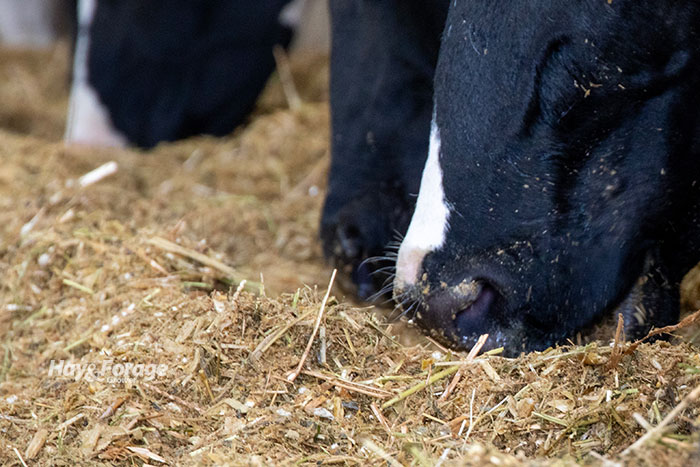
Feeding a higher percentage of forage in dairy cow diets is a strategy that’s growing in popularity as homegrown feeds become more cost-effective compared to high-priced commodities. High-forage diets also promote the production of milk components, which helps enhance milk checks.
In a recent Iowa State University Extension Dairy Team webinar, Gail Carpenter, an extension dairy specialist, discussed how dairy farmers can feed a high-forage ration while still maintaining a high level of milk production.
Carpenter began by pointing to a survey of New York dairy producers who are feeding high-forage diets. These farms had experienced higher milk component levels, improved cow longevity, higher income over feed costs, and better overall cow health as a result of feeding more dietary forage.
“Feeding a high-forage diet is going to require that top-quality forages be harvested and that an adequate forage inventory be maintained,” Carpenter asserted. “A lot of the improvements in fiber digestibility have allowed nutritionists to better utilize forages while maintaining milk production.”
To emphasize the importance of forage quality, she noted that each 1 percentage unit bump in undigestible neutral detergent fiber at 240 hours (uNDF240) results in a 0.84-pound reduction in dry matter intake (DMI).
Physically effective fiber also needs to be considered. “It keeps the rumen in good working order by providing a rumen mat and a favorable ecosystem for rumen bacteria to grow,” Carpenter explained. “Physically effective fiber is often assessed using the Penn State Particle Separator. It’s generally accepted that at least 50% of the forage should be retained on the 8-millimeter screen.
“How high we can go with a heavily forage-based diet is often dictated by NDF intake and its digestibility,” Carpenter continued. “Generally, we assume NDF intake will be about 1.1% to 1.2% of a cow’s body weight; however, this can sometimes be a little higher with an extremely digestible fiber source.”
Carpenter noted that some feed additives can be used to improve the overall digestibility of forages. She often recommends 1.5 to 2 pounds of sugar as an energy source for rumen bacteria. Direct-fed microbials and yeast additives also have been shown to improve rumen health and fiber digestibility.
A corn silage conundrum
“Corn silage is a tricky one, especially when we’re talking about forages,” Carpenter said. “Our ration software programs consider corn silage to be a forage, although there is also a lot of grain being fed, too. Most ‘high-forage’ diets use corn silage as the primary forage source, so also consider NDF intake, not just the percent forage in the ration.”
Carpenter asked the question: “Can too much forage hurt rumen health if our primary ‘forage’ is corn silage?” Her answer was “yes.”
She offered an example of a 70% forage ration with 33.5 pounds of corn silage and 5 pounds of alfalfa haylage being fed on a dry matter basis. This resulted in a ration that was 31% starch and only 20% peNDF. “This would be a red flag for me,” the dairy specialist said.
“High-forage diets are a balancing act,” Carpenter noted. “Too much starch from corn silage isn’t good, but feeding too much traditional forage that is high in NDF and low in digestibility can limit intake. Grass forages are useful to help balance the starch in a high-corn silage diet because of an elevated NDF content that is very digestible,” she added.
More forage needed
Carpenter emphasized that forage inventory is important to consider when shifting to a high-forage ration. “First, there is the realization that you’ll be feeding more forage, but as forage quality improves, dry matter intake also increases,” she said. “It’s possible that you would need 15% to 30% more storage space when shifting to a high-forage diet.”
In addition to more robust forage inventories, Carpenter said that regular monitoring of forage quality and dry matter intake is required when feeding high-forage diets. She also noted that rations would be bulkier, so a larger total mixed ration (TMR) mixer may be needed.
Although too much digestible fiber and too little physically effective fiber can cause rumination problems, Carpenter said that both reduced-lignin alfalfa and brown midrib (BMR) corn silage can still be utilized. She noted the flexible harvest window that the reduced-lignin alfalfa can provide and suggested only feeding BMR corn silage to transition and high-milking cow groups, noting that this requires a separate storage structure for the BMR corn silage.
“You can’t out-feed bad management,” the dairy specialist asserted. “Overall management in all areas needs to be stepped up with a high-forage diet.”
Carpenter emphasized the importance of not overstocking barns, keeping feed in front of and in reach of cows, routinely monitoring feed dry matter, minimizing feed waste, separating first-lactation cows, maintaining low days in milk, and keeping clean water available.”
“I think we are going to see more high-forage diets in the coming years, and we’re going to get better at using them,” Carpenter concluded. “We also need to start focusing on pounds of components, not just pounds of milk.”

